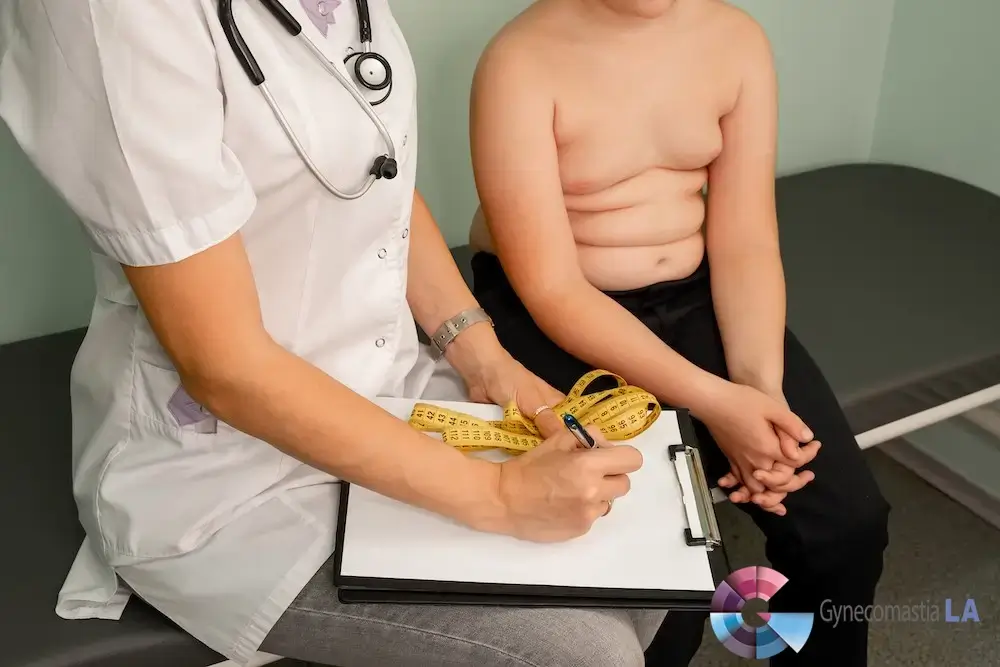
Introduction to Gynecomastia Revision Surgery
Gynecomastia Revision Surgery is a procedure designed to address and correct complications or unsatisfactory results from previous gynecomastia surgeries. Gynecomastia, often referred to as "man boobs," is a condition characterized by the enlargement of breast tissue in males. The purpose of Gynecomastia Revision Surgery is to restore a firm and attractive appearance to the breasts, helping to alleviate any emotional or physical discomfort caused by the initial procedure.
The procedure itself is a minimally invasive technique that combines liposuction and excision. Liposuction is used to remove excess fat, while excision is employed to remove any remaining glandular tissue. By utilizing these two techniques, the surgeon can effectively sculpt the chest and achieve a more desired contour and definition.
Gynecomastia Revision Surgery is commonly performed on an outpatient basis, meaning that patients can typically return home on the same day as the surgery. The choice of anesthesia is determined by the doctor and the patient, taking into consideration factors such as personal preference, medical history, and the extent of the revision needed. Options may include local anesthesia with sedation or general anesthesia.
Signs of a Botched Gynecomastia
Gynecomastia, commonly referred to as male breast enlargement, is a condition characterized by the development of excess breast tissue in men. While this condition can be emotionally distressing and impact self-esteem, medical advancements have made treatment options widely available. However, there are instances where the corrective procedures may not yield the desired results, leading to what is known as a botched gynecomastia procedure. In this article, we explore the signs that can indicate a botched gynecomastia treatment, helping individuals identify potential problems and seek appropriate follow-up care. Understanding these signs is crucial for anyone who has undergone or is contemplating gynecomastia surgery, as it empowers them to recognize when further intervention might be needed and ultimately achieve the desired outcome.

Chest Skin Redundancy
Chest skin redundancy, also known as chest skin laxity or chest skin sagging, refers to the excessive or loose skin on the chest area. This condition can be attributed to various causes including aging, weight loss, and genetics.
As individuals age, the natural loss of collagen and elastin in the skin leads to a decrease in skin elasticity, making it more prone to sagging, including the chest area. This can result in excess skin and a lack of firmness. Similarly, significant weight loss can contribute to chest skin redundancy as the skin is not able to shrink back to its original size and shape.
Common symptoms of chest skin redundancy include sagging or drooping of the skin in the chest area, the presence of folds or creases, and a loss of skin tone and firmness. It can also cause discomfort or self-consciousness for some individuals.
Treatment options for chest skin redundancy vary depending on the severity of the condition. Non-surgical options include lifestyle changes such as maintaining a healthy weight, regular exercise to improve muscle tone, and adopting a skincare routine that promotes collagen production.
For more significant cases, surgical interventions like a breast lift or chest contouring procedures may be recommended. These surgical procedures involve removing excess skin and reshaping the chest area to achieve a more youthful and toned appearance.
Scar tissue formation:
Scar tissue formation can have a significant impact on the appearance and results of male breast reduction surgery. When scar tissue develops after the surgery, it can result in a lumpy and uneven appearance of the chest. This can lead to asymmetry and misshapen breasts, which may not achieve the desired outcome of the surgery.
One of the challenges that scar tissue poses for secondary surgeries is that it can make contouring more difficult. Scar tissue is tougher and more fibrous than normal tissue, making it harder to manipulate and shape during subsequent surgeries. This can limit the ability of the surgeon to achieve the desired contour and can result in less predictable outcomes.
Additionally, the amount and quality of scar tissue that forms can vary from person to person, leading to a lack of predictability in the surgical results. While some individuals may experience minimal scar tissue formation and maintain a smooth and even appearance after surgery, others may develop excessive scar tissue that can cause significant aesthetic concerns.
Skin Laxity
Skin laxity, particularly in relation to the breasts, is commonly caused by several factors. One significant cause is the natural aging process, which leads to a decrease in the production of collagen and elastin. These proteins are responsible for maintaining the skin's elasticity, resulting in a loss of firmness and bounce-back ability. Hormonal changes, such as those experienced during pregnancy or menopause, can also contribute to skin laxity in the breasts.
The effects of skin laxity are most noticeable in the breasts, with the tissue becoming saggy and drooping. The breasts may appear deflated, losing their youthful shape and projection. This can have a negative impact on a person's self-esteem and body confidence.
To address this issue, an excision of unwanted skin is often required to tighten and flatten the breasts. This surgical procedure, commonly known as a breast lift or mastopexy, involves the removal of excess skin, rearrangement of the breast tissue, and repositioning of the nipple and areola. The excision helps to reshape the breasts, providing a more youthful and uplifted appearance. By eliminating the saggy tissue, the breasts regain their firmness and contour, enhancing the overall appearance.
Crater Nipple
Crater nipple, also known as nipple inversion or retraction, is a condition characterized by the inward folding or sinking of the nipple into the breast. It can affect both men and women and may occur in one or both nipples. While it is often harmless, it can cause cosmetic concerns and sometimes indicate an underlying health issue.
The exact cause of crater nipple is not fully understood, but it can be influenced by factors such as genetics, breastfeeding, trauma to the breast, or changes in breast tissue. Symptoms typically include a visible indentation or dimple at the center of the nipple, retracted or inverted nipple appearance, and difficulty in breastfeeding or nipple stimulation.
Treatment options for crater nipple depend on the severity of the condition and the individual's preferences. Non-surgical approaches may include nipple piercing, the use of suction devices to draw the nipple out, or the application of topical creams or ointments. Surgical procedures, such as nipple correction surgery or breast augmentation, may be recommended for severe and persistent cases.
Crater nipple is often associated with chest wall deformities, such as pectus excavatum (sunken chest) or pectus carinatum (protruding sternum). These deformities can impact the overall appearance of the chest and contribute to the development of nipple inversion. Seeking expert advice from a healthcare professional or plastic surgeon is crucial for addressing this issue, as they can provide a comprehensive evaluation, diagnosis, and personalized treatment plan.
Chest Asymmetry
Chest asymmetry is a common concern in male breast reduction surgeries, where one breast may appear larger or sit at a different projection than the other. There can be several causes for this asymmetry, such as variations in the amount of glandular tissue, differences in fat distribution, or variations in muscle and bone structure.
To address chest asymmetry in male breast reduction surgeries, several potential solutions can be considered. First, the surgeon may perform liposuction to achieve a more symmetrical distribution of fat. Additionally, they may remove excess glandular tissue or perform breast tissue sculpting to improve symmetry. In some cases, the surgeon may also need to reposition the nipple to achieve better symmetry.
An experienced plastic surgeon plays a crucial role in assessing and addressing any discrepancies in breast projection and nipple symmetry. They will carefully evaluate each patient's condition, thoroughly analyzing the underlying causes of chest asymmetry. Then, they can devise a customized surgical plan that accounts for the individual variations in order to achieve the most harmonious outcome. By employing their experience and expertise, they can skillfully perform the necessary adjustments to create a more balanced and natural appearance.
Choosing a board certified surgeon with extensive experience in gynecomastia correction is paramount in achieving successful results. This certification ensures that the surgeon has undergone rigorous training and has demonstrated proficiency in performing these procedures. With a wealth of experience, they have encountered various cases and can confidently address any issues that may arise during surgery. Moreover, their expertise greatly reduces the risk of complications and maximizes the chances of achieving the desired outcome.
How Long Do You Have to Wait Before a Gynecomastia Revision?
After undergoing gynecomastia surgery, patients may desire a revision surgery to further improve the appearance of their chest. However, it is crucial to understand the recommended waiting period before undergoing gynecomastia revision surgery. This waiting period allows for proper healing of post-surgical swelling and scar tissue, ensuring optimal results.
Typically, patients are advised to wait at least six months to one year before considering a gynecomastia revision surgery. This waiting period is essential because it allows enough time for the initial swelling to subside and for the scar tissue to heal and mature. Swelling is a natural response to any surgical procedure, and it needs time to resolve completely.
Scar tissue formation is an inevitable part of the healing process, and it takes time for the scars to soften and fade. By waiting for six months to one year, the body can repair and remodel the scar tissue, resulting in less noticeable scars after the revision surgery.
Furthermore, rushing into a revision surgery before the initial swelling has subsided can lead to inaccurate assessments of the final outcome. Waiting allows the surgeon to accurately evaluate the results of the initial surgery and make necessary adjustments during the revision procedure.
Pros and Cons of a Gynecomastia Revision
A gynecomastia revision surgery, also known as male breast reduction revision, involves a secondary procedure to correct any issues or address concerns that may have arisen from the initial surgery. Here are the pros and cons of a gynecomastia revision:
Pros:
1. Correcting asymmetry: One of the primary benefits of a revision surgery is the ability to address any asymmetry that may persist after the initial surgery. This can help achieve a more balanced and natural-looking chest appearance.
2. Boost confidence: Gynecomastia can significantly impact a person's self-esteem and body image. A revision surgery offers an opportunity to further enhance the results, leading to increased self-confidence and improved mental well-being.
3. Improved aesthetic outcomes: A revision surgery allows the surgeon to refine the results achieved in the initial procedure, ensuring a more satisfactory outcome. This can include further fat or gland removal, tightening of the skin, or reshaping the chest contour.
Cons:
1. Residual swelling: After a gynecomastia revision, it is common to experience residual swelling. This can take several weeks or even months to subside fully. Patients must be patient and willing to wait for the swelling to resolve to see the final results.
2. Similar side effects and recovery time: The recovery process and potential side effects of a revision surgery are similar to those of the initial procedure. This includes bruising, swelling, discomfort, and the need to wear compression garments.
In conclusion, a gynecomastia revision surgery can offer several benefits, such as addressing asymmetry and boosting confidence. However, there are also potential disadvantages, such as the need to wait for the swelling to subside and the similarity in side effects and recovery time to the initial surgery.
Gynecomastia Revision Procedure
A gynecomastia revision procedure is a surgical technique used to correct and improve the appearance of male breasts affected by gynecomastia. The steps involved in this procedure are as follows:
1. Administration of Anesthesia:
Before the surgery begins, the patient will be placed under anesthesia. This may involve either general anesthesia or intravenous sedation, depending on the complexity and extent of the revision required.
2. Making Incisions:
Once the patient is anesthetized, the surgeon will make incisions around the nipples (areolas). These incisions are strategically placed to minimize their visibility after the healing process is complete.
3. Removal of Fat and Tissue:
The next step involves the removal of excess glandular tissue, fat, and skin. The surgeon will carefully extract these from the breast area using specialized surgical techniques. This step aims to achieve a flatter and firmer chest contour.
4. Liposuction:
In some cases, liposuction may be used to remove excess fat. Small cannulas are inserted through the incisions, and the fat cells are suctioned out, allowing for better chest definition.
5. Fat Grafting:
In many cases, the transfer of fat back to correct a nipple crater deformity or more subtle irregularities may be necessary.
6. Skin Tightening with Renuvion J plasma:
Tightening of fibroseptal network located below the skin surface is an important means of correcting skin laxity resulting in the sagging of the chest.
7. Wedge excision of the inframammary crease:
In rare, cases, it might be necessary to resect the skin at the inframammary crease to not only eliminate skin redundancy but also in an attempt to either reposition the nipple areola with a nipple transposition or even a nipple graft.
8. Stitching Up Incisions:
After the removal of excess tissue and fat, the surgeon will stitch up the incisions carefully. This step is crucial as it helps tighten the remaining skin, ensuring a more defined contour.
By following these steps, a gynecomastia revision procedure can successfully address gynecomastia-related concerns and restore a more aesthetically pleasing appearance to the male breast area. It is important to consult with a qualified and experienced plastic surgeon to determine if this procedure is suitable and to discuss individual expectations and desired outcomes.
How Long Does It Take to Recover From Gynecomastia Revision?
Recovering from gynecomastia revision surgery involves various factors and follows a specific timeline. The duration of recovery varies depending on individual cases, but there are general aspects to consider.
Factors that influence recovery after gynecomastia revision surgery include the extent of the procedure, the patient’s overall health, and adherence to post-operative instructions. The timeline for recovery typically spans several weeks to months.
Returning to work and daily routine usually takes about one to two weeks after surgery. However, strenuous physical activities should be avoided for about four to six weeks to ensure proper healing. During this initial period, patients can expect swelling and bruising to gradually decrease. By the four- to six-week mark, these symptoms are generally significantly reduced.
Temporary numbness in the chest is a common occurrence after gynecomastia revision surgery. Patients may experience reduced sensation in the operated area during the first few months of recovery. However, it is important to note that this numbness is temporary, and full sensation typically returns within nine to 12 months.


How Much Does a Gynecomastia Revision Cost?
Gynecomastia revision surgery costs can vary due to several factors. These factors include the surgeon’s fee, anesthesia, and the surgical facility.
The surgeon’s fee is a significant factor that influences the cost of gynecomastia revision surgery. Highly experienced and reputable surgeons may charge more due to their expertise and skill. Surgeons with a higher level of training and a proven track record in gynecomastia revision are likely to command a higher fee. Additionally, the complexity of the case and the amount of revision required can also impact the surgeon’s fee.
Anesthesia is another factor that affects the cost. The type of anesthesia used, such as local or general anesthesia, can influence the price. General anesthesia, which requires an anesthesiologist to administer and monitor the patient, tends to be more expensive than local anesthesia.
The surgical facility is another determining factor in the cost of gynecomastia revision surgery. High-end facilities with advanced equipment and amenities may charge more than smaller, less equipped clinics. The location of the facility can also have an impact, as facilities in urban areas may have higher overhead costs, resulting in higher procedure fees.
Overall, the factors considered to determine the price of gynecomastia revision surgery are the surgeon’s fee, anesthesia costs, and the surgical facility fees. These factors vary based on the complexity of the case, the surgeon’s expertise, the type of anesthesia, and the quality of the surgical facility used. It is essential for patients to fully understand these factors and discuss them with their surgeon during the consultation process to determine an accurate cost estimate.
Is a Gynecomastia Revision Worth It?
Gynecomastia revision surgery may be considered worthwhile for several reasons based on the background information provided. Firstly, it can significantly improve an individual’s self-esteem and overall quality of life. Gynecomastia, or the development of excess breast tissue in males, can cause emotional distress and embarrassment, leading to a negative body image. By undergoing a revision surgery, individuals can achieve a more masculine chest appearance, boosting their self-confidence and well-being.
Cosmetic concerns also play a crucial role in considering gynecomastia revision. Many individuals desire an ideal figure that aligns with their personal aesthetic preferences. In some cases, the initial gynecomastia surgery may not achieve the desired results, leaving patients with unsatisfactory outcomes. Revision surgery offers an opportunity to further refine the chest appearance, ensuring the desired cosmetic outcome is achieved.
Furthermore, unsatisfactory results from the initial surgery could also be a reason to consider gynecomastia revision. These may include asymmetry, irregularities, or residual breast tissue. Revision surgery allows for corrections and improvements, ensuring a more proportionate and natural-looking chest contour.
Gynecomastia Revision Surgery Summary
Gynecomastia revision surgery is a procedure performed to correct any persistent or recurring issues with enlarged male breasts following a previous gynecomastia surgery. This surgical intervention typically involves a combination of liposuction and excision techniques.
Gynecomastia revision surgery is commonly performed on an outpatient basis, meaning that the patient can return home on the same day as the procedure. The patient may be placed under intravenous sedation or general anesthesia to ensure their comfort and safety during the surgery.
The specific placement of incisions on the chest will depend on the surgeon’s preference and the severity of the enlarged breasts. Typically, small incisions are made around the nipple-areola complex or in the underarm area, allowing the surgeon to access the excess breast tissue. In some cases, additional incisions may be made along the lower border of the chest or in the armpit region to enable the removal of excess fatty tissue.
Liposuction is commonly used during gynecomastia revision surgery to remove any remaining fatty tissue in the chest area. This technique involves the insertion of a thin tube, known as a cannula, into the incisions. The cannula is then used to suction out the excess fat, resulting in a more sculpted and masculine chest contour.
Excision techniques may also be employed to remove any remaining glandular breast tissue. This involves the careful removal of the excess tissue through the incisions. The surgeon may also make use of a combination of liposuction and excision techniques to achieve the desired outcome.
